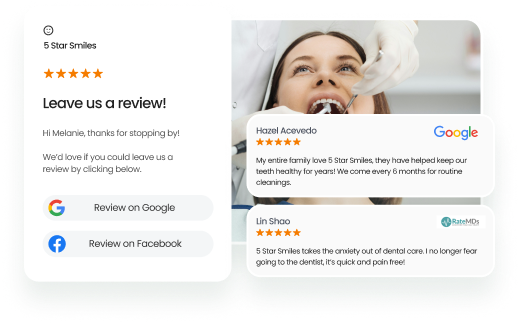What differentiates between a patient who leaves feeling frustrated and one who walks out singing your praises? It’s not just about treatment; it’s about how patients feel throughout their entire journey. Do they feel heard? Understood? Valued? Learning how to improve patient satisfaction is key to ensuring that every interaction leaves a lasting positive impact.
A great patient experience goes beyond healthcare. It’s about how healthcare providers communicate and make patients feel confident in their treatment. When done right, it leads to better patient satisfaction scores, stronger patient relationships, and higher ratings on publicly reported ratings like the Hospital Consumer Assessment.
In this blog, we’ll discuss how to improve patient satisfaction, patient satisfaction vs. patient experience, ways to boost patient engagement and ensure that every patient leaves your facility feeling heard, respected, and cared for.
Table of contents
- What is patient satisfaction?
- Patient satisfaction vs patient experience
- The importance of patient satisfaction in healthcare
- Key strategies on how to improve patient satisfaction and experience in healthcare
- Leveraging technology to improve patient satisfaction scores
- How to measure patient satisfaction
- FAQs about patient satisfaction
- Transforming healthcare one satisfied patient at a time with Birdeye
What is patient satisfaction?
Patient satisfaction is a key indicator of how well healthcare providers and organizations meet patients’ expectations and needs.
Two people can get the same care but feel differently about it. Why? Because satisfaction depends on personal expectations; what feels ‘great’ to one might feel ‘just okay’ to another.
The next section focuses on the details of patient satisfaction vs patient experience.
Patient satisfaction vs patient experience
While patient satisfaction and patient experience often go hand in hand, they are not the same. You need both to create strong, lasting relationships with patients, but it’s important to understand how they differ.
Imagine two patients, Cherry and John, both visit the same clinic. Both are treated kindly, have short wait times, and receive clear instructions.
- Patient experience: Both Cherry and John went through the same steps — smooth check-in, friendly doctor, fast service.
- Patient satisfaction: Cherry might be thrilled and rate it 10/10 because it exceeded her expectations. John, however, expected a free follow-up call and rates it 7/10.
Even though their experience were same, their satisfaction scores were different because of their personal expectations.
Seven key points to help you spot the difference between patient satisfaction and patient experience
| Patient Experience | Patient Satisfaction |
| 1. Focuses on what actually happened during the patient’s journey (e.g., wait times, communication, facility cleanliness). | 1. Focuses on how the patient feels about the care they received and whether it met their expectations. |
| 2. Objective — based on specific, measurable events. | 2. Subjective — based on the patient’s personal feelings and opinions. |
| 3. Involves all interactions with healthcare staff, systems, and processes. | 3. Involves how patients evaluate those interactions |
| 4. Can be standardized across patients since all patients experience similar steps in care delivery | 4. Can vary widely since each patient has different expectations. |
| 5. Answers: “What happened during the visit?” | 5. Answers: “Was I happy with what happened?” |
| 6. Healthcare teams can map and improve patient experience by fixing workflows and service points. | 6. Satisfaction is improved by aligning care delivery with patient expectations and preferences. |
| 7. Patient experience impacts satisfaction, but satisfaction also depends on expectations beyond the actual experience. | 7. Satisfaction reflects whether the experience matched or exceeded what the patient hoped for. |
Let’s now understand why patient satisfaction plays such a critical role in healthcare.
The importance of patient satisfaction in healthcare
Nowadays, patient feedback is more accessible than ever, with hospital comparison websites and publicly available patient satisfaction surveys influencing healthcare choices. As a result, healthcare organizations must prioritize patient experience to maintain their reputation and attract new patients.
With solutions like Birdeye Reviews AI, healthcare providers can streamline the process of collecting reviews, managing feedback, and enhancing their online reputation.
Let’s explore why patient satisfaction is a key driver of success and how to enhance it.
1. Patient satisfaction impacts patient retention
When patients feel valued, respected, and engaged, they’re more likely to return for future visits and recommend your practice to others. This directly contributes to higher patient retention and long-term growth for healthcare facilities.
How to enhance patient retention:
- Personalize communication with customers across digital platforms to ensure patients receive timely follow-ups and a seamless experience.
- Use Birdeye Messaging AI to keep in touch with patients via text, social, email, and webchat, all from a single inbox.
- Streamline appointment scheduling and reminders to create an exceptional patient experience.
Pro tip: Never miss a call, even when you’re away. Birdeye Messaging AI’s automated receptionist answers calls and transcribes voicemails, so you can stay connected and follow up at your convenience.
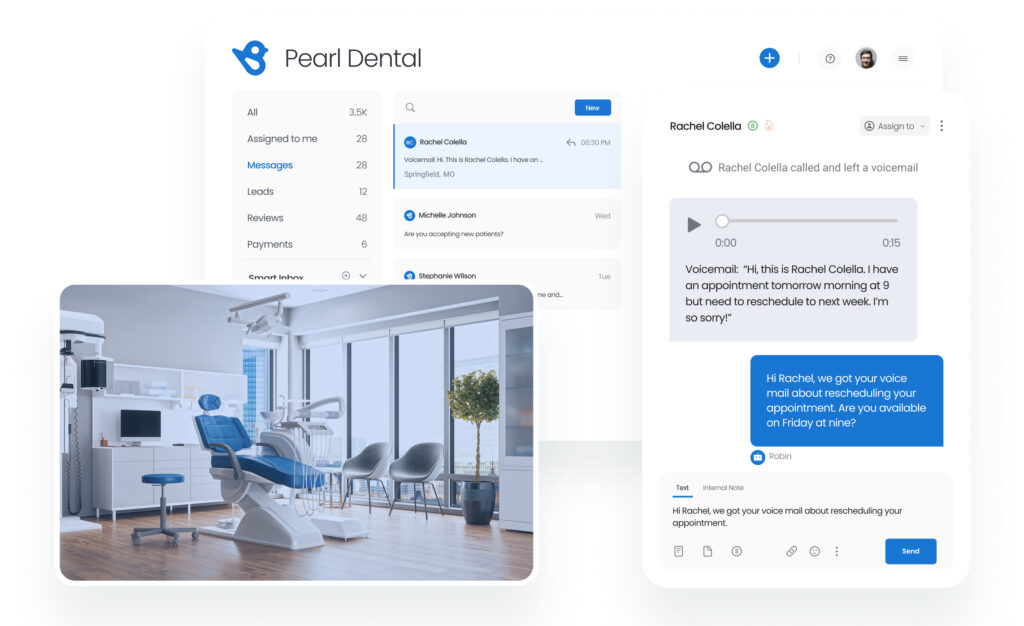
2. Better patient satisfaction brings better health outcomes
Satisfied patients are more likely to follow their prescribed treatment plans, adhere to medication regimens, and engage in preventive care, reducing the risk of complications. Their trust in healthcare providers fosters better communication, ensuring they stay informed, and committed to their health journey.
How to improve health outcomes:
- Implement patient education programs to ensure they fully understand their care plans.
- Pairing Birdeye with your CRM allows you to generate reviews effortlessly and craft GenAI responses, ensuring a seamless and engaging patient experience. Use Birdeye integrations to seamlessly connect with existing CRM and over 3,000 software systems, improving patient follow-up and engagement.
- Encourage patient feedback through automated review requests, helping you assess and refine patient care strategies.
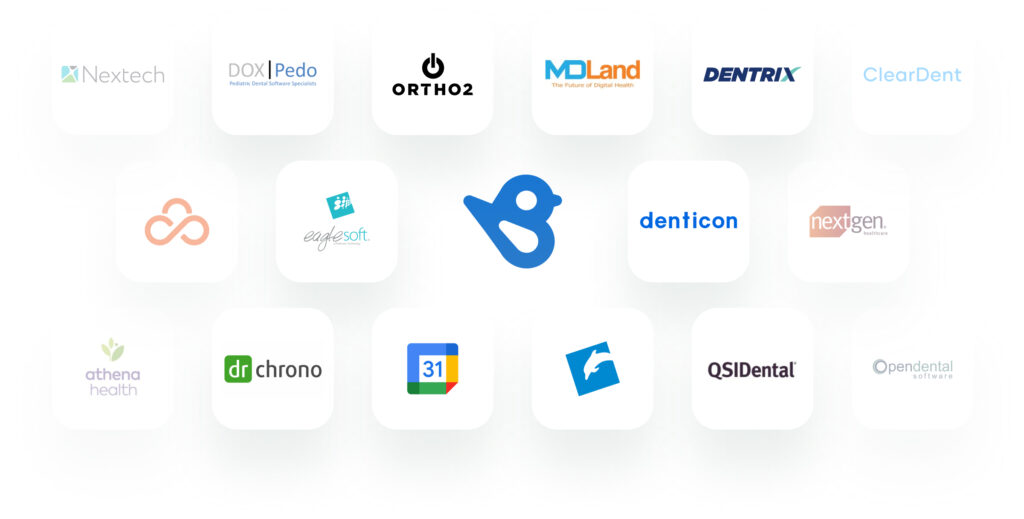
3. Public reviews depend on patient satisfaction
With platforms like hospital compare and patient satisfaction surveys, patient feedback is more influential than ever. High patient satisfaction scores improve credibility, attract new patient visits, and differentiate your facility in a competitive healthcare system.
How to boost your online reputation:
- Easily collect reviews and improve online reputation with Birdeye Reviews AI—automating review collection and generating responses with a single click.
- Maintain a proactive approach to publicly reported ratings by addressing patient concerns promptly and improving the quality of care.
- Implement real-time sentiment analysis with BirdAI, a powerful omnichannel technology for gauging patient perceptions and optimizing patient engagement.
The future of healthcare is patient-first, and the time to act is now! With platforms like Birdeye, healthcare providers can supercharge patient communication, gather real-time feedback, and create an unmatched patient experience.
Those who prioritize exceptional care will lead the way—and with the right tools, it’s easier than ever to make it happen. Next up are some key strategies to improve patient satisfaction.
Key strategies on how to improve patient satisfaction and experience in healthcare
Utilize these proven strategies to enhance patient satisfaction and experience, eliminating concerns about how to improve patient satisfaction in hospitals.
1. Enhance patient communication
Effective patient communication is the foundation of increased patient satisfaction. Patients who struggle to understand medical terminology may feel disconnected from their care, leading to frustration and lower engagement. Healthcare providers and systems must prioritize clear and compassionate communication to build trust and confidence.
Solutions:
- Avoid medical jargon and use simple, easy-to-understand language to inform patients about their conditions and treatment.
- Encourage positive interactions by training physicians in active listening and open-ended questioning to enhance patient interactions.
- Implement patient portals where patients can access medical records, test results, appointment reminders, and essential health information.
- Leverage Birdeye Chatbot AI to engage website visitors, answer questions, book appointments, and convert potential patients into loyal ones. This GenAI assistant ensures a seamless healthcare facility experience by providing instant responses and increasing engagement.
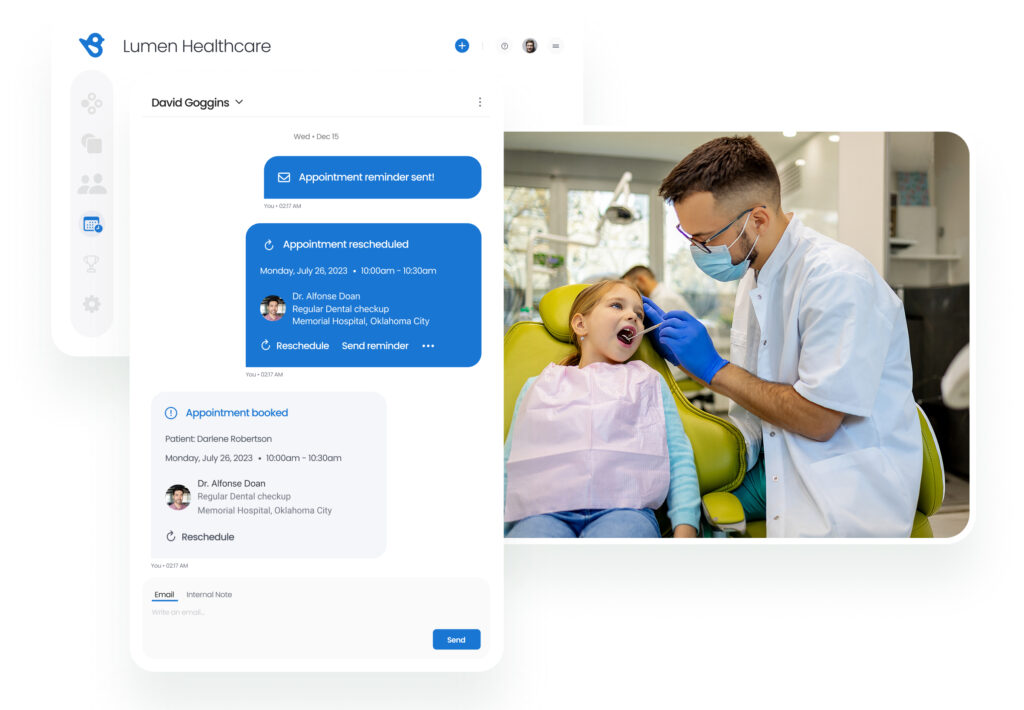
2. Optimize appointment booking & waiting room experience
Long wait times are a major source of dissatisfaction and negatively impact patient satisfaction scores. A stressful waiting experience can lower patient trust and engagement.
Solutions:
- Offer digital check-in options to streamline the check-in process and reduce wait times for in-person visits.
- Provide real-time updates via text messages or patient portals, ensuring patients feel involved in their care.
- Design a comfortable facility environment with calming décor, entertainment, and refreshments to make waiting less stressful.
- Utilize the hospital compare website to benchmark wait time improvements and enhance overall clinical quality.
- Allow patients to opt for mutiple booking options where they can book appointments online, via phone, or through a mobile app.
- Show available time slots instantly so patients can quickly select-confirm or reschedule appointments without delays.
3. Improve physician and healthcare team interactions
Patients seek positive interactions with their care team. Feeling valued and heard by healthcare services/staff increases patient confidence, fostering higher patient satisfaction and patient loyalty.
Solutions:
- Train the care team to maintain eye contact, sit down during consultations, and show empathy in patient interactions.
- Implement bedside shift reports to inform patients about their care and involve them in decision-making.
- Encourage hospital staff to introduce themselves and explain their roles to improve the patient’s perspective and clinical safety.
4. Educate and Empower Patients
Patient education plays a vital role in fostering better health outcomes. When patients understand their treatments, medications, and care plans, they are more likely to adhere to medical advice and feel actively involved in their care.
Solutions:
- Provide easy-to-read brochures and digital materials covering medication education, treatment plans, and preventive care.
- Offer digital tools that help patients track their health progress and understand clinical outcomes.
- Encourage patients to ask questions and take notes during visits to ensure they are well-informed about their care.
Delight patients, earn trust—one experience at a time
Want to see the impact of Birdeye on your business? Watch the Free Demo Now.
5. Address pain management and comfort
Unmanaged pain can significantly impact patient safety and clinical quality, leading to negative patient feedback. Ensuring effective pain management is essential for quality improvement initiatives.
Solutions:
- Regularly assess pain levels and tailor treatments to individual patient needs.
- Offer alternative pain relief options where appropriate, ensuring a patient-centered approach.
- Train care providers to recognize signs of discomfort and provide timely relief to enhance the healthcare facility experience.
6. Enhance post-care engagement
A comprehensive post-care engagement strategy improves patient retention and satisfaction. Patients want to feel supported beyond their immediate treatment.
Solutions:
- Implement post-appointment follow-ups via phone calls, text messages, or patient portals to check on recovery and answer any concerns.
- Send reminders for upcoming tests, treatments, or wellness checkups to ensure continued patient engagement.
- Utilize digital tools such as mobile apps and patient portals to provide quick access to post-care instructions and additional support.
- Personalize follow-up routines to meet individual patient needs, improving patient satisfaction scores and long-term adherence to care plans.
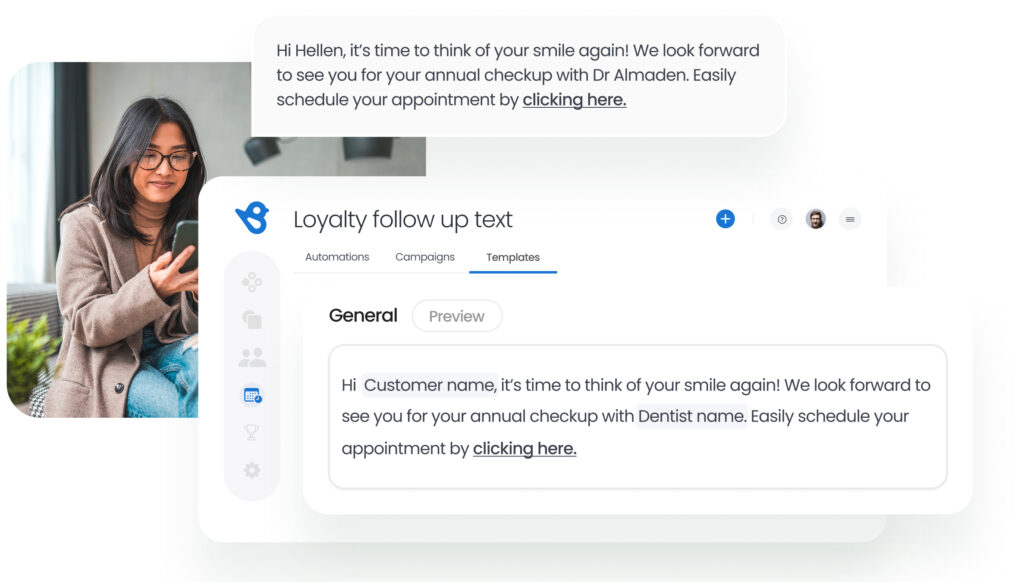
7. Simplify the financial journey
A complex billing process can be a major pain point for patients. Providing a transparent and seamless payment experience is essential for boosting publicly reported patient satisfaction scores.
Solutions:
- Offer detailed, easy-to-understand bills that clearly outline all charges.
- Provide well-trained staff to address billing inquiries and reduce patient frustration.
- Implement digital billing systems that allow patients to view and pay bills online, ensuring a smooth financial experience.
- Offer multiple healthcare payment options and flexible financing plans to accommodate diverse financial needs.
- Utilize Birdeye Payments to enable effortless payments via text, QR code scans, card readers, websites, and automated collections, ensuring timely and hassle-free transactions.
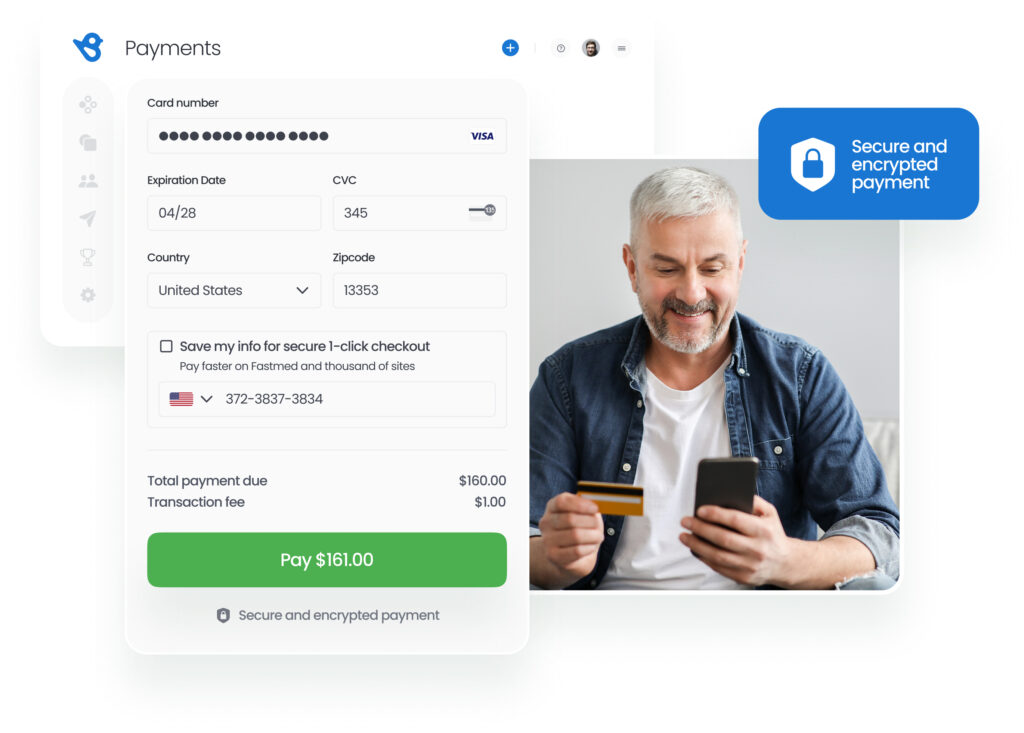
Healthcare organizations that embrace these strategies will improve their publicly reported ratings, foster long-term patient loyalty, and achieve superior clinical outcomes.
Leveraging technology to improve patient satisfaction scores
If you’re wondering how to improve patient satisfaction scores, focus on implementing key technologies that enhance care quality and elevate the patient experience
1. Implement patient portals for better engagement
Patients want to be involved in their care. Patient portals allow them to:
- View test results
- Schedule appointments
- Access their medical history
- Communicate directly with healthcare providers
With Birdeye, healthcare providers can enhance patient engagement by sending automated appointment reminders via text and email, ensuring patients receive timely updates about their upcoming visits.
By simplifying appointment management, patient portals help to:
- Reduce no-shows
- Improve scheduling efficiency
- Create a seamless patient experience
- Drive long-term patient loyalty
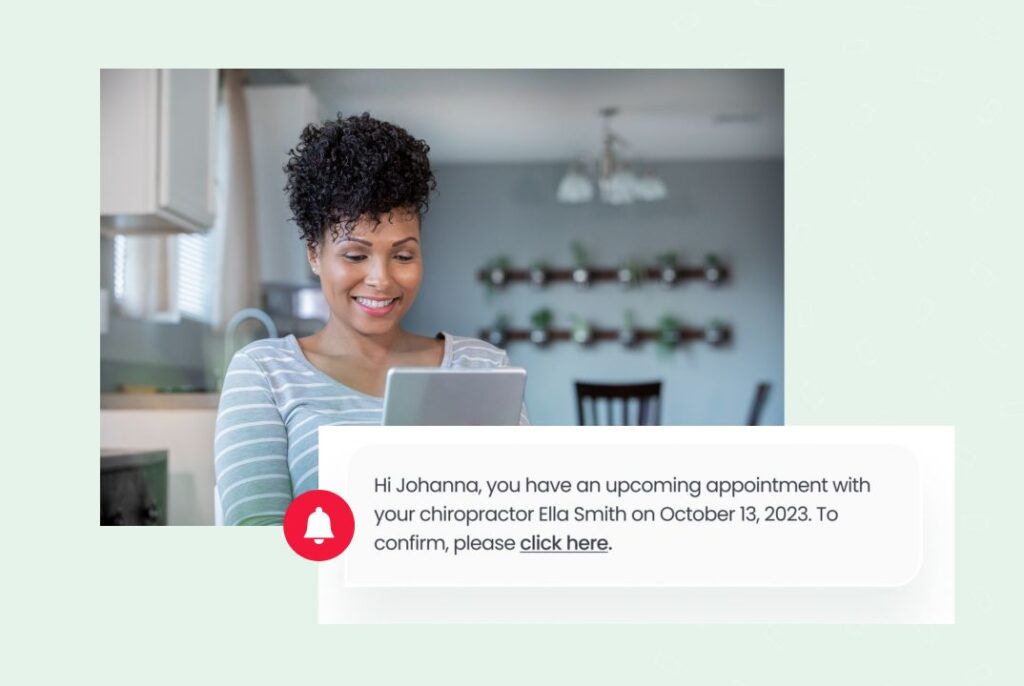
2. Utilize patient satisfaction surveys for real feedback
To deliver a positive patient experience, healthcare services must actively seek and analyze patient satisfaction data. Patient experience surveys allow healthcare organizations to collect valuable insights into patient expectations, preferences, and areas needing improvement.
These surveys play a critical role in measuring healthcare quality, ensuring that care teams align with patient-centered care principles and enhance overall health outcomes.
By leveraging patient experience measures, healthcare facilities can:
- Identify recurring pain points in the patient journey and implement solutions for improvement.
- Assess clinical outcomes and patient perceptions of care effectiveness.
- Foster patient retention by addressing concerns and enhancing engagement.
- Utilize data-driven strategies to refine workflows, optimize services, and improve patient education efforts.
Patient satisfaction surveys provide actionable feedback that empowers providers to deliver better patient outcomes while ensuring long-term improvements in healthcare quality.
3. Improve the billing process for a seamless patient experience
One of the most frustrating aspects of the patient journey is dealing with unclear and complex billing. A lack of price transparency may result in confusion, stress, and dissatisfaction. Addressing these financial concerns is crucial for patient retention and ensuring a positive patient experience.
Solutions for simplifying the billing process:
- Ensure price transparency by clearly outlining expected costs before treatment, helping patients make informed decisions.
- Provide flexible payment plans for expensive procedures, making high-quality care accessible to all.
- Streamline bills with clear, easy-to-understand summaries, eliminating confusion and offering better patient care
- Enhance patient education on insurance coverage, payment options, and financial assistance programs to reduce uncertainty.
A simplified billing process significantly improves patient experience measures, leading to greater trust, higher patient retention, and improved patient outcomes.
How to measure patient satisfaction
Health systems can continuously improve patient experience scores and positive health outcomes by using standardized metrics, digital tools, and real-time feedback. Some of the effective ways to measure patient satisfaction success include:
1. Track HCAHPS scores
The Hospital Consumer Assessment of Healthcare Providers and Systems (HCAHPS) is a nationally recognized survey that measures healthcare quality and patient experience.
Tracking HCAHPS scores allows healthcare organizations to identify strengths and weaknesses in their clinical processes, improving patient-provider relationships and service delivery.
By analyzing these scores, healthcare facilities can:
- Gain insights into patient satisfaction and expectations
- Identify gaps in quality care and develop targeted improvement strategies
- Benchmark their performance against national standards to remain competitive
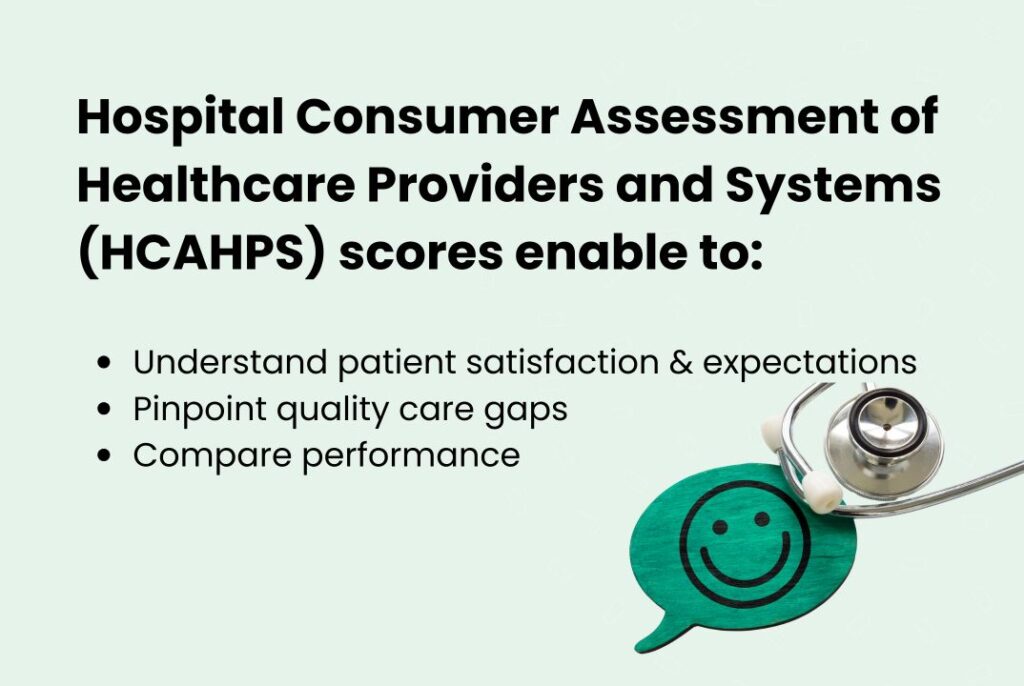
2. Use the hospital compare website
Patients rely on hospital compare websites to evaluate and select the best healthcare facilities based on patient satisfaction scores. A strong digital presence and high ratings are crucial in healthcare systems’ reputations.
To maintain a strong standing:
- Prioritize patient-centered care initiatives that boost overall healthcare quality.
- Regularly review and update information on hospital compare platforms to reflect the most recent quality improvement efforts.
- Actively respond to patient experience concerns to enhance transparency and trust.
3. Monitor online patient reviews
Online healthcare reviews have become one of the most influential factors in healthcare services. Patients frequently turn to review platforms to make informed decisions about their care, making it crucial for healthcare services to actively engage with feedback.
Ways to manage online feedback with Birdeye Reviews AI:
- Monitor reviews from a single dashboard that streamlines review management.
- Easily tag, respond, and assign reviews as tickets to ensure timely follow-ups and issue resolution.
- Address patient feedback professionally and transparently, improving trust and credibility.
- Use sentiment analysis to gain deeper insights into patient-provider relationships and areas needing improvement.
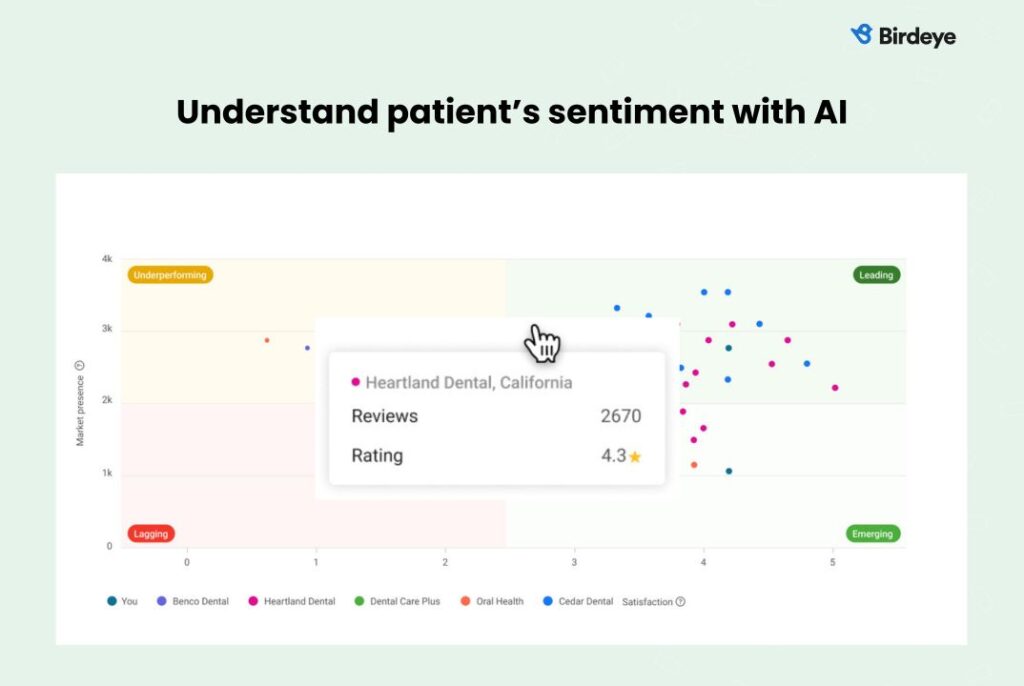
By implementing these strategies, healthcare providers and systems can effectively measure and enhance patient satisfaction, ensuring ongoing improvements in healthcare quality.
FAQs about patient satisfaction
Healthcare organizations can improve patient satisfaction by enhancing patient communication, ensuring positive interactions, and implementing quality improvement initiatives focusing on patient-centered care and safety.
Effective patient communication helps inform patients, reduces confusion, and fosters trust between patients and their care team, leading to better engagement and positive interactions.
Quality improvement initiatives enhance patient safety, streamline healthcare processes, and ensure a positive patient experience, ultimately increasing patient satisfaction.
Providers can enhance patient interactions by actively listening, addressing concerns promptly, and encouraging open discussions, which creates a more patient-centered approach.
A well-trained care team plays a critical role in ensuring patient safety, delivering quality care, and fostering positive interactions that increase patient satisfaction.
Transforming healthcare one satisfied patient at a time with Birdeye
Whether enhancing patient communication, simplifying administrative processes, or leveraging digital tools to boost patient engagement, every step brings healthcare providers closer to delivering seamless, patient-centered care.
By implementing these strategies, healthcare providers can strengthen patient-provider relationships, increase patient retention, and drive better clinical outcomes. Creating a patient-first approach isn’t just an industry best practice—it’s an essential investment in the future of healthcare systems.
If you’re looking for innovative ways to enhance the patient experience, consider Birdeye. The all-in-one platform empowers healthcare organizations with tools for better visibility, patient choice, and service quality.
From enabling Webchat for instant communication to automating review requests and optimizing reputation management, Birdeye provides the solutions you need to improve patient satisfaction and grow your practice.
Ready to offer improved patient satisfaction? Get started with Birdeye today. Watch a demo now.

Originally published
![[Feature image] Top Strategies on How to Improve Patient Satisfaction Effectively](https://birdeye.com/blog/wp-content/uploads/Feature-image-Top-Strategies-on-How-to-Improve-Patient-Satisfaction-Effectively-1140x596.jpg)








